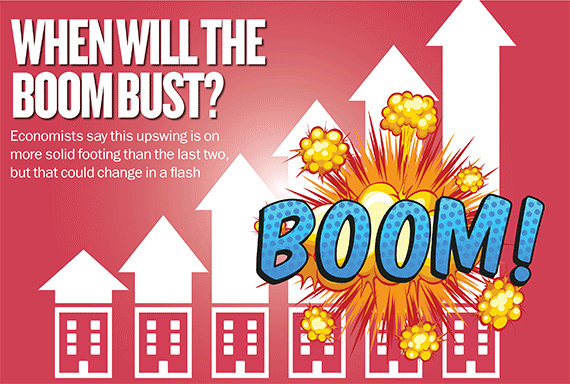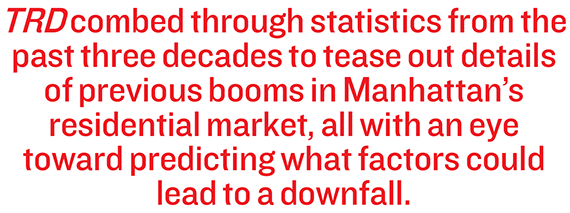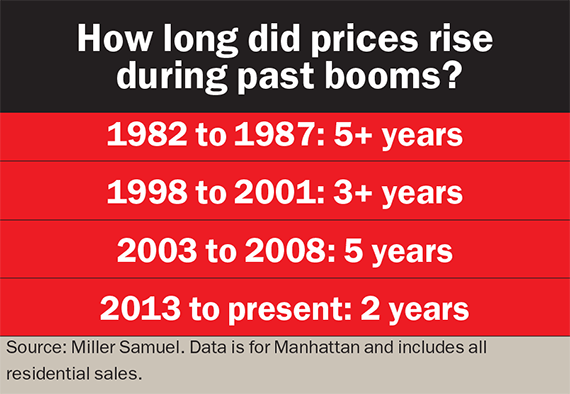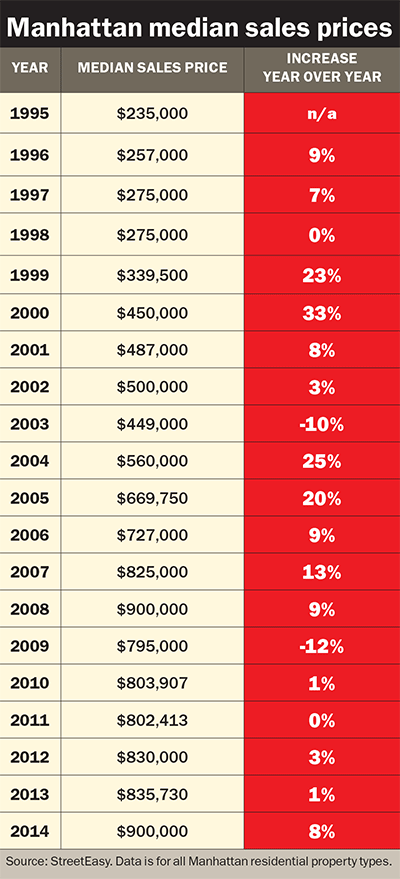Trending
When will the boom break?
Economists say this upswing is more solid than the last two

The word “boom” may conjure up images of skyrocketing prices and massive amounts of construction — at least when discussed in real estate circles.
But the truth is that not all market booms (or busts for that matter) are created equal.
This month, The Real Deal combed through statistics from the past three decades and talked to market veterans to tease out details of previous booms in Manhattan’s residential market, all with an eye toward predicting how high the current market can rise and what factors could lead to its downfall.
What we discovered is that while there is much discussion about prices getting too high for both residential properties and development sites, economists said this boom is being built on a more solid foundation than past booms.
To be sure, there has been some price softening recently in the higher-end of the market, giving both developers and brokers pause, but lenders who got burned in the last downturn have helped keep the market in check.
During the market run-ups in the 1980s, 1990s and the early aughts, prices shot up higher and faster. In addition, there were even more new residential units added to the market.
Of course, hindsight is always 20-20, and predicting what will lead to the next bust is easier said than done. This time around, for example, there’s concern about artificially low interest rates, the record prices developers are paying for land and the unprecedented emphasis on building to the luxury market.

The question is when will those issues, or other unforeseen factors, prompt the market to take a turn for the worse.
“Will it end? One hundred percent,” said Noah Rosenblatt, founder of real estate analytics firm Urban Digs. “But nobody knows when.”
Room for (price) growth
While much has been made about how much prices jumped in the last few years, today’s price gains actually pale in comparison on a percentage basis to the increases seen in prior booms.
A look back shows that the boom of the 1990s saw prices rise by about 84 percent, and they jumped a staggering 116 percent during the boom of the early aughts, according to real estate appraisal firm Miller Samuel. This time around, prices have only increased by about 19 percent since the first quarter of 2013, when they began trending upward. (Prices did start recovering in 2010, but significant increases didn’t come until later.)
“In the context of prior booms, it feels like we’re still in the early stages,” said Jonathan Miller, Miller Samuel’s president.
According to listings website StreetEasy, Manhattan’s median prices have been steadily climbing for 27 consecutive months, the second-longest rise since 2003.
Prices have been rising slowly, said Alan Lightfeldt, StreetEasy’s data scientist, “but that’s in line with what we believe is a healthy market.”
He said the opposite was true in 2006 and 2007, when there were 19 months of steep price gains, followed by the market crash.

In addition, there are different catalysts driving the current price growth compared to past booms.
As Miller pointed out, prices in 2004 were driven by “fast and loose credit.” At that time, inventory levels were rising rapidly, as homeowners were rushing en masse to sell their properties and cash out at the top of the market.
“There was a panic,” Miller said. “People didn’t want to be left behind.”
Now, prices are rising for the opposite reason. “People can’t sell their homes because they have low equity and as a result, there’s an inventory shortage,” Miller said.
That inventory shortage at least partially stems from today’s tighter lending standards. Those standards — which are a direct response to the lax financing that caused the last bust — not only make it more difficult for borrowers to secure loans, but also keep a lid on asking prices, which discourages homeowners from selling.
In new development, asking prices have increased more, but because many developers were forced to stop building during the recession, experts say there is still more demand than supply. The average new development price last year was $2.5 million, according to Corcoran Sunshine Marketing Group, more than 30 percent higher than the average price of $1.9 million in 2007.
Barbara Denham, an independent economist who has worked for several large commercial real estate firms in New York City, said she believes that prices have room to go higher than they did in the last cycle “given how sound the lending market has been.”
Brokers said the fact that prices are rising more slowly than they did in previous cycles is a good thing. “In previous cycles, I saw a steep rise, almost a straight line going up,” said Douglas Elliman broker Jacky Teplitzky. “In a market where prices go up so rapidly, the chances of those prices coming down in a drastic way are also quite high.”
An “L” shaped recovery
The past few up markets came crashing down in response to global economic events.
 Five years into the boom of the 1980s, for example, the 1987 stock market crash plunged the city into a deep recession. The dot-com crash in 2000 halted a subsequent up-cycle, a downturn that was exacerbated by the World Trade Center attacks on Sept. 11, 2001.
Five years into the boom of the 1980s, for example, the 1987 stock market crash plunged the city into a deep recession. The dot-com crash in 2000 halted a subsequent up-cycle, a downturn that was exacerbated by the World Trade Center attacks on Sept. 11, 2001.
Most recently, the U.S. housing bubble that burst in late 2007 led to the collapse of Lehman Brothers and other investment banks in 2008, helping usher in a global financial crisis and setting off a multi-year real estate decline.
Given that each of the last three booms were halted by such unique circumstances, their duration bears little impact on how long today’s up-market will last, sources say.
Urban Digs’ Rosenblatt said booms tend to mimic the equity markets. This boom, he said, will keep going “as long as stocks are doing what they’re doing.”
Still, the market’s personality during a bust, and its subsequent recovery, can hint at what’s to come.
For example, following the 1980s bust, the market experienced a “V-shaped” recovery — meaning that it dropped fast, but then bounced back quickly, mirroring the vertical shape of the letter V.
“The longer [the bust] goes, the harder it will be to recover,” said David Frame, an assistant professor of real estate at Baruch College’s Zicklin School of Business.
“If it’s short … people can get through that,” Frame said, offering the example of someone who is renting an apartment but then gets laid off. “Maybe you can borrow some money or use savings. … If it starts going on for three or six months to a year, those resources tend to get used up.”
According to Frame, the current recovery has been “L-shaped” in the sense that the economy didn’t bounce back quite as fast.
The New York City real estate market, analysts recall, began to percolate around the end of 2010. That movement, Miller said, was prompted by buyers and sellers believing the Bush-era tax cuts were about to expire. Prices then “moved sideways” for several years, meaning they were relatively flat, until 2012. In early 2013, Miller said, “People got off the fence and we started to see the mood change.”
Craig Lazzara, a senior director at the ratings agency Standard & Poor’s, said the slow and steady price increases since indicates that the growth is “sustainable rather than a bubble.”
“The rate of increases are still positive, but they’re going up at a decelerating rate,” Lazzara said. “At a certain level, I think it’s good.”
Absorbing supply
While the rebound of the 1990s moved at about the same clip as the current rebound has, it was followed by a bust characterized by a massive amount of overdevelopment.
“Because of overbuilding and high conversion activity of the 1980s,” Miller said, “it literally took seven years for the oversupply to be absorbed.”
Today, there’s not the same level of concern about new units being absorbed, given the city’s inventory shortage.
“Other boom markets have seen a large amount of development that’s behind the surge in prices, but here, only now are we starting to see a decent amount of new development,” said Greg Heym, chief economist at Terra Holdings, the parent company of brokerages Brown Harris Stevens and Halstead Property. He said there’s currently a 4.4 month supply of apartments in Manhattan.
Last year, more than 2,400 new units hit the market and this year, nearly 6,000 new condos are set to come online, according to Corcoran Sunshine.
But that’s far less than the 8,000 units that launched in 2007. Plus, new development still accounts for just 10 percent of sales in Manhattan, according to Miller.
At the peak of the last boom in 2006, he said new development and newly converted residential units accounted for nearly 58 percent of sales.
Stephen Kliegerman, president of Halstead Property Development Marketing, noted that the same tighter lending standards that are affecting homebuyers are being applied to developers as well, resulting in a slower expansion of new development. “Lenders are more prudent than they had been in the past,” he said. Also, there’s less developable land.
According to Miller, new development market share could reach 20 percent, but he said it is unlikely new development market share will reach 2006 levels.
During the last cycle, developers flooded the market with studios, one- and two-bedrooms. “The units [developed today] are bigger,” he said.
In fact, the booms of the last three decades have each had distinct characteristics in regard to new development.
In the 1980s, for example, there was a massive frenzy among developers to convert rental apartments to co-ops. During that 10-year span, 3,000 rental buildings in Manhattan and more than 242,000 rental units were converted into co-ops, according to a 1998 New York
Times report.

“Landlords were just cashing out,” said Donna Olshan, president of Olshan Realty, noting that landlords were offering tenants the opportunity to buy co-ops in the building at a steep discount. Olshan — who purchased her own rental apartment around that time for $28,000 and flipped it eight years later for $225,000 — said that this led to huge bump in the sales volume.
The condo boom in the early aughts, meanwhile, also ushered in the age of the amenity-laden apartment.
That boom started a market-share shift between co-ops and condos. Condos now make up 40 percent of the market, compared with 30 percent in 1989. Co-ops, which made up 70 percent of the market in 1989, now represent 60 percent of the market.
Nowadays, of course, new development is skewing toward larger and more expensive condos.
“New development and luxury [are] rising faster than the overall market,” said Miller. “It’s not a proxy for anything else; it’s more of a side effect of the last decade’s hangover.”
Leaning toward luxury
As a whole, today’s market is far more dependent on luxury buyers than ever before.
Unlike the early aughts, when anyone could get a loan, stricter mortgage requirements this time around have given all-cash buyers a leg up in the market, and demand from well-heeled buyers is fueling the development of luxury condos.
That’s all well and good, unless that pool of buyers dries up.
Today, the average luxury pad is 4.3 times as expensive as the average Manhattan apartment, according to Miller. That gap has grown. For the past three decades, he said, the luxury market was three times the price of the rest of the market.
In fact, the luxury market has grown so rich that in the past decade, a new price category has emerged for apartments priced $10 million and up. In the 2014 fourth quarter alone, there were 35 properties sold for $10 million or more, compared with just four a decade earlier, in the fourth quarter of 2004.
In the last year, Miller Samuel began charting an even loftier category of apartments priced at $30 million and up.
“You’ve got this new price point that has been created,” Miller said. “It represents a tiny sliver of the overall market, but it’s the most visible.”
In 2014, the average price of luxury co-ops and condos topped $7.3 million, up 64.4 percent from $4.5 million in 2005.
While some of the price acceleration reflects an uptick of international demand, land and construction costs have also escalated. “They have to build based on the cost of land,” Miller said.
Today’s land prices demand larger apartments with bigger price tags to generate return. “Developers are paying much more for the land, so they need to get more money [out of the project] to justify the expense,” said Richard Anderson, president of the construction industry’s trade group, the New York Building Congress.
It may seem counterintuitive, but the resurgence of the ultra-luxury market is a byproduct of the financial crisis. “The market before was all about leverage,” said Miller. “Risk was ignored.”
These days, fueled by low interest rates, investors in the U.S. and around the world are looking to invest in hard assets.
“When you see declines in oil prices, and political instability around the world, people look for safe investments and Manhattan real estate offers that,” said Heym. “It doesn’t have a day where it drops 5 percent like the stock market would.”
The tech factor + the foreign fixation
A massive influx of foreign buyers, along with the growth of the tech sector in Manhattan, has also changed the landscape for the current boom.
“It’s your typical supply and demand equation,” said Halstead’s Kliegerman. “If demand increases because of the introduction of a new demographic or buyer, that causes the market to strengthen, because you have a greater pool to pull from.”
The boom of the 1990s and early 2000s was driven by the expansion of the financial services sector.
This time around, companies ranging from Twitter to Facebook to Google are part of the economic mix in a serious way. That’s adding both office tenants and residents to the market.
“They’re coming, being fairly well paid, and so New York is a much more diversified economy than 10, 15 years ago,” said Baruch’s Frame. “As long as the sectors that formed the economic base … perform well, it’s hard to imagine a catastrophic change in real estate. I don’t think we’ll see the 1970s again” when the city faced bankruptcy, crime was rampant and residents fled to the suburbs.
As hard as it may be to believe, the Great Recession that began in 2008 was only the fourth-worst recession in the past century, according to an analysis by TRD in 2010.
To be sure, New York City shed roughly 65,000 jobs between January 2008 and April 2010. But by comparison, the city lost 551,900 jobs during the 70s recession, 195,700 jobs during the savings-and-loan crisis in the 80s, and 113,700 jobs after the World Trade Center attacks.
And Denham said the fact that Wall Street’s financial firms have just started to show job growth indicates that the economy is more diversified and employment numbers will “stay robust going forward.”
But in addition to the tech sectors, the influx of foreign money has also changed the real estate game drastically.
Global economic and political factors are pushing wealthy foreigners into New York real estate, which they see as a safe investment and a place to park cash.
Of course, without that pool of buyers, the market could take a hit.
“We’re charting new ground here because of foreign money. It’s that rush to take money and put it into a stable economy,” said high-profile broker Richard Steinberg, who left Warburg Realty last month for Douglas Elliman.
“The boom is going to last much longer,” he predicted.
But if world events turn, all bets could be off.
“Maybe there is this constant stream of foreign buyers buying these places,” said Stijn Van Nieuwerburgh, director of the Center for Real Estate Finance at New York University’s Stern School of Business.
“I just have a basic question of where these people are going to keep coming from,” Van Nieuwerburgh said. “It is a bubble, if you ask me. Have we built enough housing for the masses? Probably not.”




